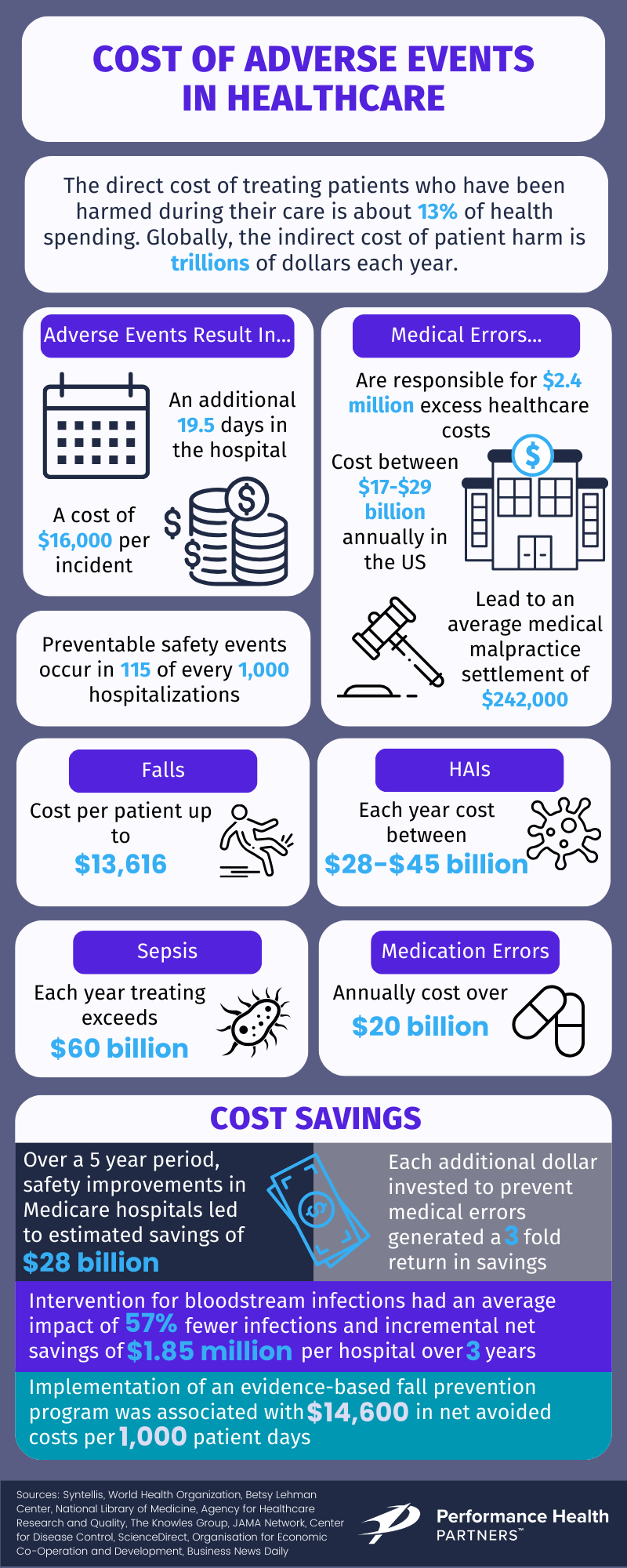3 min read
Prevent Incidents and Reduce Costs with Incident Reporting Software
Performance Health Partners
January 21, 2021
An estimated 161,250 preventable deaths occur each year in U.S. healthcare organizations, which can cause harm to a patient’s physical, mental, and financial health. (1) Read on to learn how organizations can leverage healthcare technology like incident reporting software to prevent incidents, reduce costs, and save lives.
It is estimated that about one-third of all harmful incidents affecting patients are preventable. (2)
Traditional methods of incident reporting (often through paper or Excel) allow healthcare professionals to collect data related to safety events; however, many find it difficult to translate this fragmented data into meaningful insights for prevention.
Implementing effective incident software can help turn data into action plans that foster lasting improvement. With a user-friendly reporting system, organizations can shift their focus from simply reporting incidents to preventing them before they occur. Utilizing healthcare information technology (HIT) brings an organization closer to zero harm and allows staff to focus on delivering safe and high-quality care.
Incident reporting systems can help organizations move beyond reporting to prevent patient harm in the following ways:
1. Reduce Costs
The overall cost savings from utilizing a healthcare information technology system often greatly outweigh the initial investment.
According to a study by RAND Health, around 200,000 adverse drug events could be prevented each year if all hospitals had a HIT system. This would save the healthcare system about $1 billion annually and have significant cost savings for individual organizations. (3)
Additionally, increased safety and coordination procedures drive large savings due to reduced hospital stays, reduced staff administration time, and more efficient drug utilization. (3) For instance, adverse drug events cost more than $3,000 dollars on average and result in an average increase of the length of stay of 3.1 days. (4) Implementing a technology that allows for easier identification of adverse events can assist in managing healthcare costs make a direct impact on the bottom line.
2. Quickly Identify Performance Improvement
Incident reporting software solutions ensure consistency in reporting and quality of information. A strong incident reporting software can rapidly determine underlying causes that contribute to harmful events and pinpoint exactly where they are occurring over time. This offers organizations the ability to quickly measure and analyze recurring trends that suggest a course of action for preventing future incidents.
Evaluating current levels of organizational performance is a critical part of determining areas of improvement that can help streamline workflows and improve overall operational efficiency.

3. Foster Communication Across Departments
Communication errors are one of the most common factors contributing to the occurrence of adverse events in healthcare. (5)
Often in a patient’s medical journey, multiple healthcare professionals or departments are involved in providing care. Having an open line of communication among care teams is critically important for reducing harmful incidents and events. (5) Information regarding changes in medication, healthcare-acquired infections (HAIs), falls, or other injuries should be readily accessible across departments in a secure, centralized location. Technology-based incident reporting systems bring together data from different parts of the organization and show how errors are related from a systemic perspective rather than placing blame on an individual. (6)
4. Gain Access to Real-Time Data
Many adverse safety events are the result of clinicians not having sufficient information about a patient or drug. (3) Paper-based reporting systems can compromise data integrity or cause data to get lost in translation. Challenges of paper-based reporting may include:
- Lost paperwork
- Illegible handwriting
- Difficulty in tracking follow-up of incidents
Digital data entry is less time-consuming and reduces the risk of human error. (5) Such systems provide leadership teams with real-time information for immediate follow-up documentation and analysis. (5)
For organizations looking to improve the quality of patient care, implementing an incident reporting solution can prove to be an incredibly useful tool for getting closer to zero harm.
Performance Health Partner’s Incident Reporting Software
Implementing incident reporting software is an integral part of an effective patient safety initiative. With Performance Health Partner’s Solutions, healthcare organizations can take action against the harmful effects of safety incidents, while focusing on improving the quality of the care experience.
References:
2. https://pubmed.ncbi.nlm.nih.gov/27763744/
3. https://www.rand.org/pubs/research_briefs/RB9136.html
4. https://pubmed.ncbi.nlm.nih.gov/22435229/
5. https://www.healthitoutcomes.com/doc/ways-technology-improving-patient-safety-0001
6. https://www.ncbi.nlm.nih.gov/books/NBK20556/

